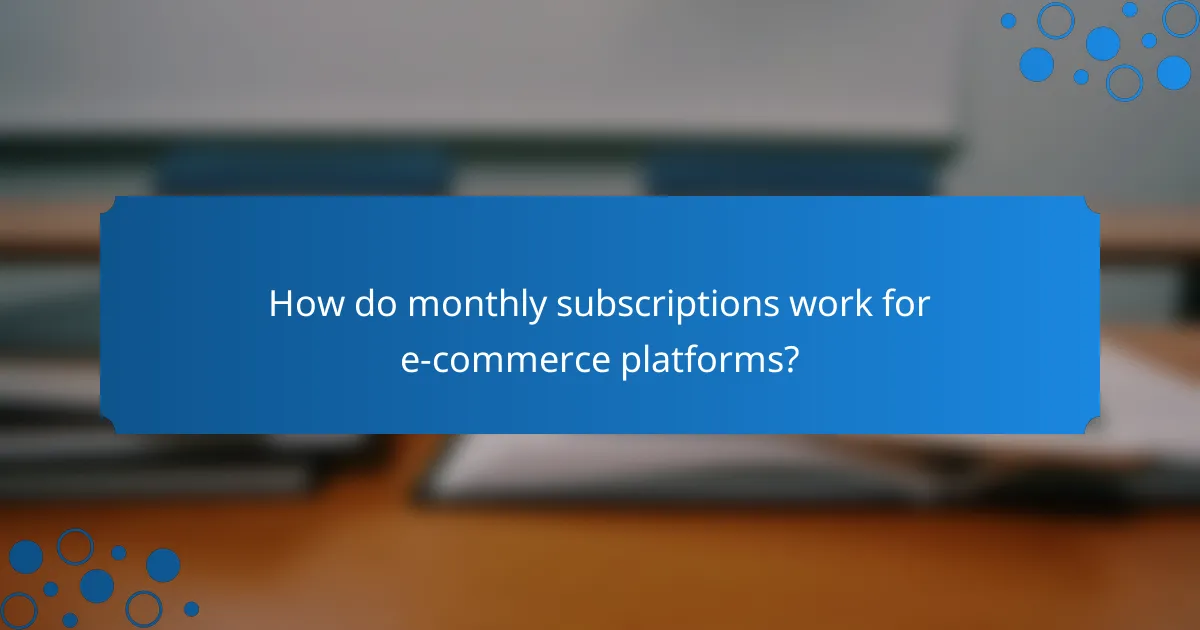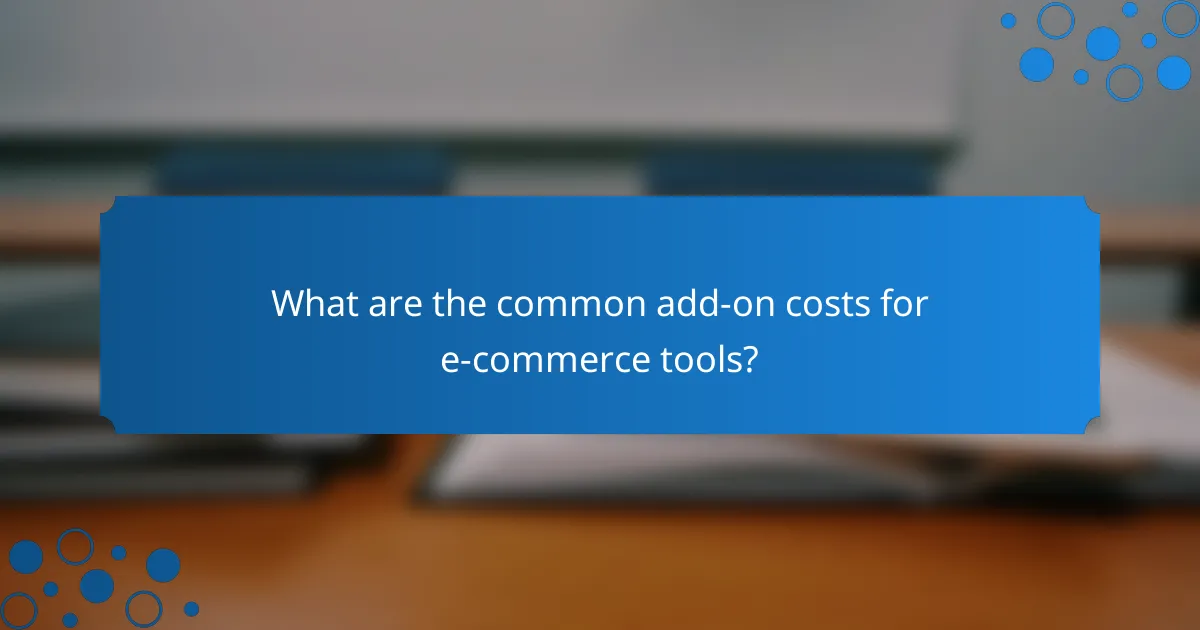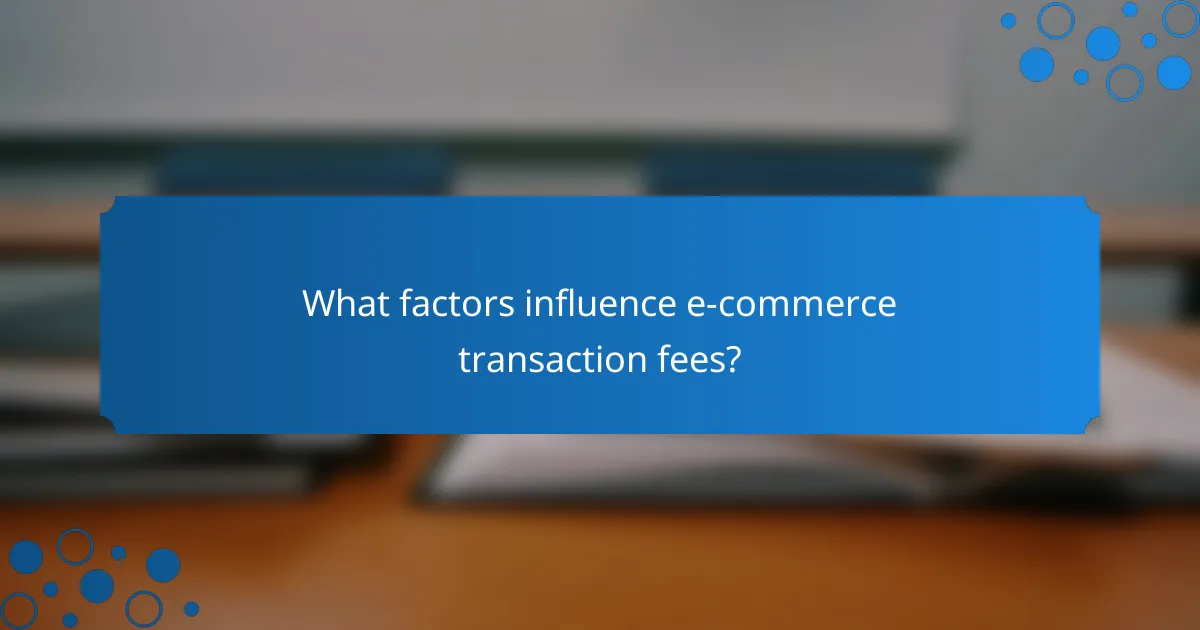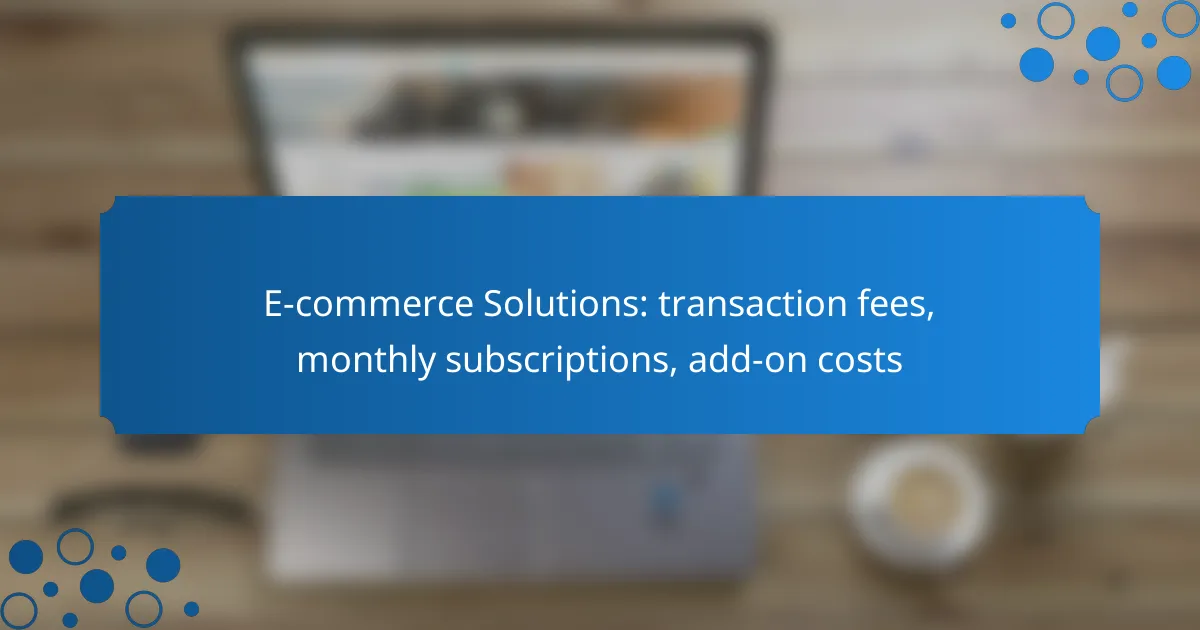E-commerce solutions come with a variety of costs that can affect a business’s bottom line, including transaction fees, monthly subscriptions, and add-on expenses. Transaction fees vary by platform and payment processor, while monthly subscriptions provide essential tools for online operations. Additionally, add-on costs such as payment gateway fees and shipping integrations can further influence overall expenses, making it crucial for businesses to carefully evaluate their options.

What are the transaction fees for e-commerce solutions in New Zealand?
Transaction fees for e-commerce solutions in New Zealand vary significantly based on the platform and payment processor used. Generally, these fees can range from a few percent of each sale to fixed amounts per transaction, along with possible monthly subscription costs.
Shopify transaction fees
Shopify’s transaction fees depend on the pricing plan you choose. For the Basic plan, fees can be around 2% per transaction if you use a third-party payment gateway, while using Shopify Payments can eliminate these fees. Additionally, there are monthly subscription costs that range from NZD 29 for the Basic plan to NZD 399 for the Advanced plan.
Consider the total cost of ownership, including both transaction fees and subscription fees, when selecting a plan. If your sales volume is high, opting for a higher-tier plan may save you on transaction fees in the long run.
WooCommerce payment processing costs
WooCommerce itself is free, but payment processing costs can vary based on the gateway you select. Common options like PayPal or Stripe typically charge around 2.9% plus a fixed fee per transaction, which can be around NZD 0.30. These fees can add up, especially for smaller transactions.
It’s important to evaluate different payment gateways to find the most cost-effective option for your business model. Keep in mind that some gateways may offer lower rates for higher sales volumes.
BigCommerce fee structure
BigCommerce does not charge transaction fees if you use their built-in payment processing options. However, if you opt for third-party gateways, fees can range from 2% to 3% per transaction, similar to other platforms. Monthly subscription fees start at around NZD 29 and can go up to NZD 299 depending on the features you need.
When choosing BigCommerce, assess the overall cost, including subscription and transaction fees, to determine the best fit for your e-commerce needs. The absence of transaction fees on certain plans can be advantageous for businesses with high sales volumes.

How do monthly subscriptions work for e-commerce platforms?
Monthly subscriptions for e-commerce platforms provide businesses with access to various tools and services needed to operate online stores. These subscriptions typically include features such as website hosting, payment processing, and customer support, with costs varying based on the level of service and additional features required.
Shopify subscription plans
Shopify offers several subscription plans, ranging from basic to advanced options. The Basic plan starts at around $29 per month, providing essential features for small businesses, while the Advanced plan can go up to approximately $299 per month, catering to larger enterprises with more complex needs.
Each plan includes transaction fees that decrease with higher-tier subscriptions. For instance, the Basic plan incurs a 2.9% + 30¢ fee per transaction, while the Advanced plan reduces this to 2.4% + 30¢, making it more cost-effective for high-volume sellers.
Squarespace pricing tiers
Squarespace has four main pricing tiers for e-commerce, starting from $18 per month for the Personal plan to $40 per month for the Advanced plan. The Personal plan allows for basic online selling, while the Advanced plan includes advanced shipping and discount features.
Transaction fees vary by plan, with the Personal plan charging a 3% fee on sales, while the Business and Advanced plans do not have transaction fees, making them more appealing for serious sellers. Businesses should evaluate their sales volume to choose the most cost-effective option.
Wix e-commerce plans
Wix provides three e-commerce plans, starting at about $23 per month for the Business Basic plan and going up to around $49 per month for the Business VIP plan. Each plan includes features like online payments, product galleries, and customer management tools.
Wix does not charge transaction fees on any of its e-commerce plans, which can be advantageous for businesses looking to maximize their profit margins. However, users should consider the limitations on features and storage that come with lower-tier plans when making their choice.

What are the common add-on costs for e-commerce tools?
Common add-on costs for e-commerce tools can significantly impact overall expenses. These costs typically include payment gateway fees, shipping integration costs, and marketing tool expenses, each contributing to the total cost of running an online store.
Payment gateway fees
Payment gateway fees are charges incurred when processing customer payments through your e-commerce platform. These fees can vary widely, often ranging from 2% to 5% of each transaction, plus a fixed fee per transaction, which may be around $0.30. It’s crucial to compare different payment processors to find the best rates that suit your business model.
Some gateways offer flat-rate pricing, while others have tiered structures based on transaction volume. Be aware of any additional costs for chargebacks or international transactions, as these can add up quickly.
Shipping integration costs
Shipping integration costs involve fees for connecting your e-commerce platform with shipping carriers. These costs can include monthly subscription fees for shipping software or per-shipment charges. Many platforms offer built-in shipping solutions, but third-party integrations may provide more flexibility at a cost.
When selecting a shipping solution, consider factors like ease of use, available carriers, and whether the service provides real-time tracking. Some services may charge based on the volume of shipments, so evaluate your shipping needs to choose the most cost-effective option.
Marketing tool expenses
Marketing tool expenses encompass costs associated with software and services used to promote your e-commerce business. This can include email marketing platforms, social media advertising, and SEO tools, with prices varying based on features and user capacity. Monthly subscriptions for these tools can range from $10 to several hundred dollars.
When investing in marketing tools, prioritize those that align with your business goals. Look for platforms that offer free trials or tiered pricing to test their effectiveness before committing to higher costs. Additionally, consider the potential return on investment from these tools to ensure they contribute positively to your bottom line.

What factors influence e-commerce transaction fees?
E-commerce transaction fees are influenced by several key factors, including the types of payment methods used, the volume of transactions processed, and any applicable currency conversion fees. Understanding these elements can help businesses manage costs effectively and choose the right payment solutions.
Payment method types
The type of payment method chosen can significantly impact transaction fees. Common options include credit cards, debit cards, digital wallets, and bank transfers, each with varying fee structures. For instance, credit card transactions often incur higher fees compared to bank transfers, which may have lower or even no fees.
Additionally, some payment processors charge a flat fee per transaction, while others may take a percentage of the sale. It’s essential to compare these costs when selecting a payment provider to ensure it aligns with your business model.
Transaction volume
Transaction volume refers to the total number of sales processed over a specific period. Many payment processors offer tiered pricing, where fees decrease as transaction volume increases. For example, a business processing thousands of transactions monthly may qualify for lower rates compared to a startup with fewer sales.
To maximize savings, businesses should analyze their sales trends and consider negotiating fees with providers based on anticipated growth. Keeping track of transaction volumes can help in selecting the most cost-effective payment solution.
Currency conversion fees
Currency conversion fees apply when transactions involve different currencies. These fees can vary significantly among payment processors and can add a percentage to the transaction cost. For example, if a customer pays in euros while your business operates in U.S. dollars, a conversion fee may be charged.
To minimize these costs, businesses can consider using multi-currency accounts or payment processors that offer competitive conversion rates. Always review the terms related to currency conversions to avoid unexpected charges that could impact profit margins.

How to choose the right e-commerce solution?
Choosing the right e-commerce solution involves assessing your business needs, budget, and growth potential. Focus on transaction fees, subscription models, and any additional costs to ensure the platform aligns with your financial goals.
Evaluating transaction fees
Transaction fees are charges applied by payment processors for handling sales. These fees typically range from 1.5% to 3.5% per transaction, depending on the provider and the payment method used. It’s crucial to understand how these fees will impact your profit margins.
Consider whether the e-commerce solution offers flat-rate fees or variable rates based on sales volume. Flat-rate fees can simplify budgeting, while variable rates may offer savings for higher sales volumes. Always read the fine print for any hidden fees, such as chargeback or refund fees.
Comparing subscription models
Subscription models for e-commerce platforms can vary widely, typically ranging from monthly fees of around $30 to several hundred dollars. Assess what features are included at each price point, such as hosting, security, and customer support.
Some platforms offer tiered pricing based on the number of products or sales volume, which can be beneficial for scaling businesses. Be cautious of low initial costs that may increase significantly as your business grows. Compare the total cost of ownership, including transaction fees and add-on services, to make an informed decision.
